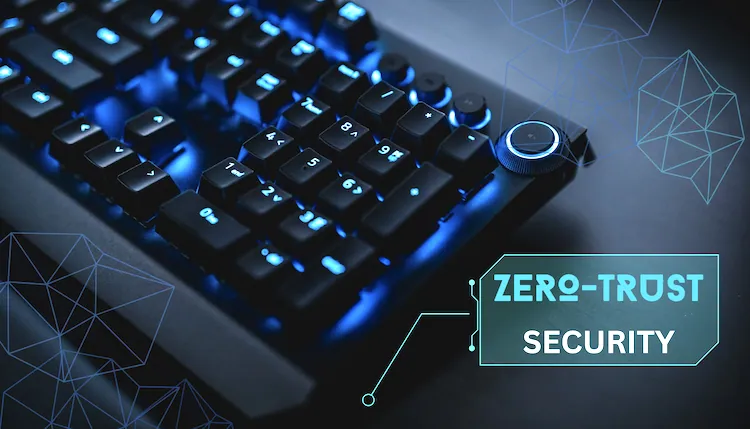In today’s interconnected AI world, where cyber threats constantly evolve, traditional security measures are no longer sufficient to protect sensitive data Enterprises are turning to a revolutionary “Zero-Trust Security” approach to safeguard their networks, systems, and valuable information.
In this article, we will discuss the concept of zero-trust security and how it benefits and shapes data protection’s future. We will also explore the five pillars of zero trust and provide an example to help you understand its implementation better.
We will also explore the zero-trust security architecture, implementation, best practices, and its significance in compliance and remote workforce scenarios.
Understanding Zero-Trust Security:
Zero-Trust Security is a comprehensive security framework that challenges the long-standing belief that entities within an organization’s network can be trusted by default. Instead, it assumes a “never trust, always verify” approach, ensuring that every access request is carefully examined, authenticated, and authorized, regardless of whether it originates inside or outside the network perimeter.
The core principle of zero-trust security lies in the strict control of access privileges. Each user, device, or application is treated as potentially malicious until proven otherwise, requiring constant verification of their identity, security posture, and compliance with security policies. This approach minimizes the risk of unauthorized access, lateral movement, and data breaches.
The Five Pillars of Zero Trust:
1. Verify: The first pillar of zero trust emphasizes verifying the identity of users, devices, and applications before granting access to resources. It involves multi-factor authentication, strong password policies, and continuous user behavior monitoring to detect anomalies or suspicious activity.
2. Limit Access: Zero trust advocates for granting the least privilege necessary for users to perform their tasks. We tightly control access permissions and only grant them on a need-to-know basis. It helps to limit any potential impact from security breaches or unauthorized access.
3. Learn and Adapt: The third pillar focuses on continuously analyzing user behavior, network traffic, and security threats. Machine learning and artificial intelligence algorithms are leveraged to detect patterns, identify anomalies, and respond proactively to potential security risks.
4. Micro-Segmentation: Zero-trust security promotes the segmentation of networks into smaller, isolated segments known as micro-segments. By creating these boundaries, organizations can contain the impact of a breach, limiting lateral movement and minimizing the exposure of sensitive resources.
5. Embrace Encryption: Encryption plays a crucial role in zero-trust security. Data in transit and at rest should be encrypted to protect it from unauthorized access. Encrypting data enhances its security by making it impossible for unauthorized individuals to access the information without the appropriate decryption keys, particularly during an attack.
Benefits of Zero-Trust Security:
Enhanced Data Protection: Organizations can significantly reduce the risk of data breaches and unauthorized access by adopting a zero-trust security model. Every access request is thoroughly examined, ensuring that only legitimate and authorized users can access sensitive resources.
Mitigation of Insider Threats: Zero-trust security places equal emphasis on internal and external threats. It helps mitigate the risk of insider threats by strictly controlling access permissions and monitoring user behavior, thus reducing the likelihood of data exfiltration or malicious activity from within the organization.
Improved Compliance: Compliance with industry regulations and data protection standards is a top priority for organizations across various sectors. Zero-trust security provides:
- Granular control and auditing capabilities.
- Facilitating compliance with regulatory requirements such as GDPR.
- HIPAA.
- PCI DSS.
Flexibility and Scalability: Zero-trust security is highly adaptable to changing business needs and evolving threat landscapes. It accommodates modern technology trends such as cloud computing, mobile devices, and remote workforces, ensuring consistent protection across diverse environments.
Reduced Damage and Response Time: In the event of a security incident, zero-trust security minimizes the potential damage by containing the breach within isolated network segments. It also enables faster incident response and remediation, reducing the overall impact on the organization.
Example of Zero Trust:
One popular example of zero trust implementation is Google’s BeyondCorp architecture. BeyondCorp is designed to provide employees with secure access to Google’s internal applications and services, regardless of location or network. Instead of relying on the traditional perimeter-based security approach, BeyondCorp adopts a zero-trust model where users and devices are continuously authenticated and authorized based on various factors, such as user identity, device health, and context.
Zero-Trust Security Architecture:
The zero-trust security architecture is designed to provide granular control and authentication mechanisms to verify and authorize users, devices, and applications. It encompasses technologies such as identity and access management (IAM), multi-factor authentication (MFA), network segmentation, encryption, and continuous monitoring.
Zero-Trust Network Access:
Zero-Trust Network Access (ZTNA) is a crucial component of zero-trust security. It focuses on providing secure access to resources based on user identity, device health, and context rather than relying on the traditional perimeter-based approach. ZTNA ensures that users and devices are continuously authenticated and authorized, regardless of location or network.
Implementing Zero-Trust Security:
Implementing zero-trust security requires a strategic approach and careful planning. Organizations need to assess their existing infrastructure, identify critical assets, and define access policies based on the principle of least privilege. They must also adopt technologies that enable continuous monitoring, anomaly detection, and behavior analysis to respond effectively to potential threats.
Zero-Trust Security Solutions:
Various vendors offer zero-trust security solutions encompassing a range of technologies, including IAM, MFA, network segmentation, encryption, and advanced threat detection. These solutions provide organizations with the tools to effectively implement and manage zero-trust security.
Zero-Trust Security Best Practices:
To ensure a successful zero-trust security implementation, organizations should consider the following best practices:
- Conduct a thorough assessment of existing infrastructure and identify critical assets.
- Implement strong identity and access management controls, including multi-factor authentication.
- Utilize network segmentation to create isolated segments and restrict lateral movement.
- Apply encryption to protect data in transit and at rest.
- Continuously monitor user behavior and network traffic for anomalies and potential threats.
Zero-Trust Security and Compliance:
Zero-trust security aligns with compliance requirements such as GDPR, HIPAA, and PCI DSS by providing enhanced security controls, access management, and auditing capabilities. It helps organizations meet regulatory obligations and protect sensitive data from unauthorized access.
Conclusion:
Organizations must prioritize implementing strong security measures as cyber threats evolve and become more sophisticated. Zero-trust security offers a proactive and dynamic approach to protecting valuable data and assets, making it the future of data protection. By adopting a zero-trust mindset and incorporating the five pillars of zero trust – verify, limit access, learn and adapt, micro-segmentation, and embrace encryption – organizations can create resilient and secure environments that effectively safeguard their most critical information from the ever-growing threat landscape.
Implementing zero-trust security requires careful planning, collaboration, and a comprehensive understanding of the organization’s unique requirements. By embracing this innovative security model, businesses can stay one step ahead of cybercriminals and ensure their data’s confidentiality, integrity, and availability in an increasingly interconnected world.











